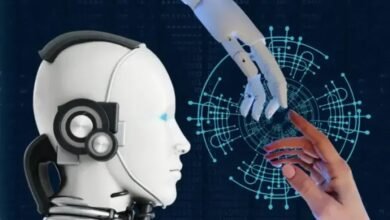Educational technology and its future challenges
Educational technology is a set of information and communication resources, processes, and tools applied to the structure and activities of the educational system in its various fields and levels.
As the world develops at a tremendous speed, teaching and learning methods are renewed and developed to keep pace with this rapid technological progress. In the era of information and communications technology, educational technologies have played a vital role in improving the quality of education and increasing its effectiveness. Educational technology represents a set of tools and resources that aim to improve the educational process and provide an interactive and interesting learning environment for students.
This article will explore the world of educational technology and its significant impact on transforming educational curricula and methods of delivering knowledge. We will take an in-depth look at the various applications of technology in education, from the use of multimedia in the classroom to the use of e-learning platforms and virtual reality to enhance the learning experience.
With the technological advances we have witnessed in recent decades, distance education and self-learning have become more available and easier than ever before, opening new horizons for comprehensive and integrated teaching and learning. The impact of these technologies on students and teachers alike will be explored, and how their interaction with knowledge can be improved through advanced technology.
We will also address the challenges and opportunities of implementing educational technology, including issues of access and equity in education, and the need to move towards using technology in a balanced and effective way to ensure that all students benefit fairly and equally.
Educational technology represents a revolutionary transformation in the field of education and is an integral part of the educational future. Therefore, exploring them and understanding their impacts is essential to improving the quality of education and enabling societies to achieve sustainable progress and development.
What role does technology have in education?
When educational problems find a solution in the use of information technology, that is, in the use of computers and more telecommunications equipment for data storage, transmission, and manipulation, we speak of technology in education.
In other words, we understand that educational technology is about the use of technological devices for educational purposes.
Currently, the staff of educational centers have the possibility of acquiring the internet, computers, digital whiteboards, mobile phones, and tablets to share their knowledge or organize classes and homework.
These facilities have managed to adapt educational methods to the digital age, where there is a greater number of teaching and learning resources for both teachers and students.
Students can access much more information through the implementation of new technologies that, by the way, also open up new spaces for entertainment and expression, such as games and blogs.
What are the pillars of educational technology?
The new educational models have been created in the awareness that the future of our society depends on three technological areas, namely: programming, robotics, and 3D printing.
These areas are the pillars of educational technology:
- Programming: Teaching programming goes beyond preparing students for a technological field of work. Students solve self-correction processes as they learn to locate errors in complex problems. Programming works by promoting the learning of logic, creativity, finding solutions, and entrepreneurship.
- robotics: Robotics is the subject that allows programming a device or robot, teaching it a set of instructions so that it executes them autonomously. Programming a robot allows students to physically see programming errors and their limits, in addition to learning the precise language. Learning this subject provides a solution to the growing demand for science and engineering in future jobs since, thanks to the advances of the digital age, people capable of programming said devices will be needed.
- 3d print: This is gaining great importance for the design of models or prototypes in various areas of our lives. Medicine, engineering, the textile industry, and more use this technology successfully, it can also be used for geography and art. Thanks to 3D printing, students learn about new technologies and their use, but it also helps them understand complex theories since it manages to exemplify them.
What changes has technology brought to education?
A few years ago, students could only access education in person. They had large amounts of books and notebooks, and searching for information manually took much longer. Information on paper was indispensable.
Technology has brought with it the possibility of studying online, which simplifies access to education in terms of place and time, finding information is much easier, and huge databases can be accessed quickly.
Today people can access information from any smart device and even attend conferences through video calls.
The creation of projects is much easier since technology has brought new tools that replace paper. In short, technology in education has made learning easier, more comfortable, and even more affordable.
The digital age does not stop, so teachers and specialists must be aware of new technologies to prepare their students.
What are the advantages of technology in education?
The advantages of educational technology are numerous.
Students can interact, play, and learn from various platforms, which fosters a climate of participation during classes. They can also learn remotely and at flexible times, and customize their lessons to suit their needs.
As for the teachers, they have excellent organizational, planning, and teaching tools, which saves a lot of time to review or move faster.
Technological platforms can integrate the entire school staff, as students share concerns, teachers manage their groups, and administrators monitor class achievements.
Thanks to educational technology, school staff can be aware of their students and attend to their needs. There is an educational software to identify early the risk of dropout, to provide support to students.
We will also mention that betting on educational technology implies, in the long run, great economic savings and even ecological care, since class materials and even transportation to attend a lesson may not be necessary.
What are the challenges of educational technology?
The implementation of technological tools and solutions in the educational field faces necessary challenges to overcome.
The benefits of using technology are obvious, but they also come with responsibilities. Adapting to change is the main task of any educational institution.
The methodology of education has changed, since the student instead of memorizing, focuses on the search, analysis, and interpretation of information.
By introducing technology into the classroom, school staff and students learn to work collaboratively.
There is a need to train teachers in the use of new technologies so that they can incorporate them into their classes. Teachers must be constantly updated with technological advances, to provide quality education.
Let us not forget that the digital age necessitates a paradigm shift in which students are no longer preparing for an industrial world but for a computerized world.
Task and evaluation systems must adapt to technology so that students can face the challenges of today’s reality.
What examples of educational technology tools are there?
We have already seen the pillars that support educational technology, it is time to deal with the most used tools that are currently in force.
The first of these is known as LMS (Learning Management System), a tool that manages online study and learning.
The various activities can be managed, distributed, and evaluated in virtual training, the idea is that learning is accessible, flexible, and friendly and involves all school staff, from administrators to students.
Another tool is virtual reality, which is the visual perception of a specific moment or environment. This is the educational field that provides the opportunity to recreate scenarios that were only found in books.
The human body, historical landscapes, places in the world, extinct animals… The students will have access to a virtual collection that will allow them to learn from experience.
Students and teachers also have access to educational video games where memory, logical reasoning, concentration, spatial orientation, and coordination are exercised.
Such experiences will help students develop useful skills for careers in engineering, the arts, and even architecture.
Finally, in higher grades, students are expected to manage tools of curricular value, organizational tools capable of sharing files instantly, communication and debate platforms, and programs that they will find in future jobs.
What can we expect from educational technology in the future?
The digital age is running fast and by leaps and bounds, and technology focused on education cannot and should not be left behind.
One of the most important aspects to focus on lies in the control of student learning. The monitoring and review of students is an important factor for the incorporation of technologies within any class.
In the end, the technological tools focus on providing solutions for student monitoring and, above all, so that they can learn and adapt to the constant changes in technology.
Another aspect is that students no longer have to follow the pace dictated by the teacher, which eliminates part of the student’s tension toward learning.
In this way, the student develops skills and aptitudes in his own time, form, and taste in a personalized way.
Simplicity, monitoring, and user adaptation are the main aspects on which educational technology can focus for the innovation of new tools and new methods of working in the future.
Education technology tools are predicted to find their way into mobile in a much better way than they do today.
Banning these devices in classrooms will be a thing of the past. The training of teachers who are capable of creating educational content for cell phones will be a necessity.
Another area of opportunity for education technology is artificial intelligence. The development of this technology has grown rapidly, but its implementation in classrooms will take a little longer.
Your drive can focus on better smart tutoring systems. We can imagine cognitive tutors mimicking the role of teachers, so they will guide the lessons in different disciplines.
Let’s think about virtual teaching that will offer solutions when students present learning problems.
We know that there are already platforms or programs that practice the role of a teacher, however, the development of artificial intelligence will reach new levels.
The prognosis is clear: this class of tools will be a central axis in teaching methods.
The benefits will be numerous, but educational institutions will need to complement advanced artificial intelligence in their face-to-face learning models and interaction with other people.
How? It is our task to find out.
Conclusion
The educational field is in a process of transition. Society is evolving from an industrial mindset to a fully computerized approach.
People’s daily lives are changing and they are facing new tools that manage to make the old methods of carrying out an activity disappear.
An example of this is the success of online shopping, as well as the rapprochement with companies through social networks. Such daily interactions with technology have changed the world and therefore educational methods.
Schools have to leave behind the old paradigms that prepare people for a world that is ceasing to exist, that is, for an industrial society.
The way schools manage time, the division of subjects, the bureaucracy of the school itself, as well as the hierarchy between administration, teachers, and students, is a foretaste of what would await the student in an industrial world.
Technological development brought with it a change of mentality and therefore a transition to the very structure of the educational field, people are already preparing for the digital age and some jobs could not be dreamed of before.
It is essential to have an educational system based on Educational Technologies, which encompasses and provides a solution to human needs for the challenges of the present.
Education does not focus on memorization but on analysis, concentration, and decision-making. Educational technology presents simple and adaptable tools to the needs of students and the society where they develop.





